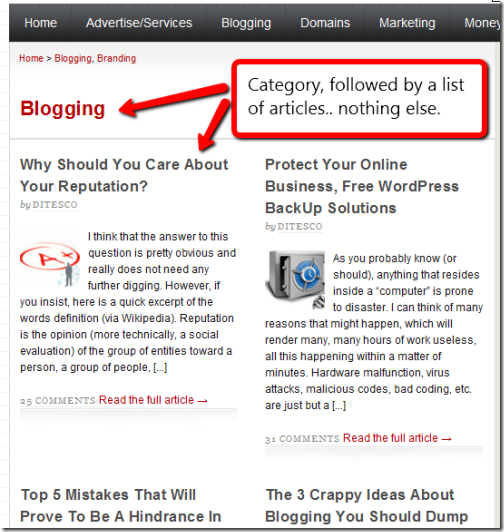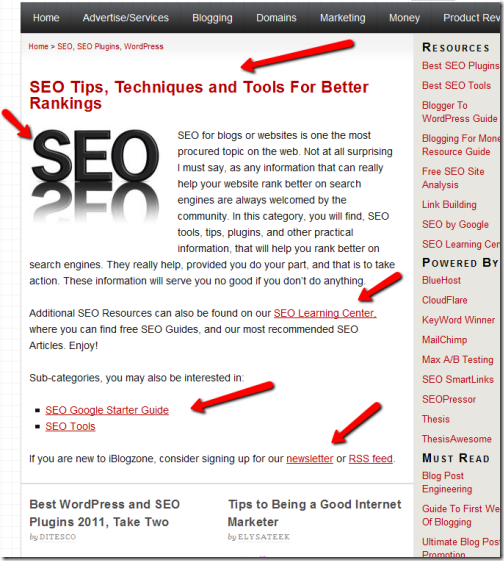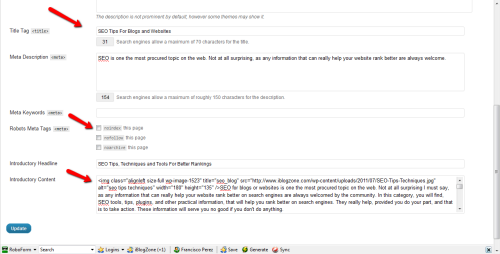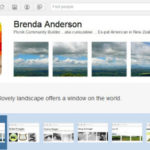One of the most common things you will find on almost any website is probably a “menu”. A menu is part of a navigation structure, that webmasters use, to direct users to specific parts of their website. Think of it as some sort of “road signs” pointing you to certain directions. The objective of using menus is to facilitate users to find content that are not immediately available when they land on any of your pages. Granted, one of the easiest ways to construct a menu is by using a category based type menu, which not only helps to let your visitors know what your site is about, but also provides them with an easy access to your content.
Some experts says that a proper navigation structure is an important part of improving users experience. Can’t argue with that, and this is why, we point our visitors towards certain categories, so that they can see what content we have to offer on each of those categories. When a user clicks on a category, they will be presented with a list of “articles” related to that category. This list could be in form of excerpts (teasers) or in some cases full posts, which I suggest for you to stay away from. Having full posts under categories, can create too many disturbances for a user, and might also be a strong contender of being tagged as duplicate content.
OK, you might say. So what’s wrong with the user being presented with a list of articles? Actually, nothing wrong, but… you can always make it better.
Making Your Category Pages User and (Maybe) SEO Friendly
Rather than bombarding users with just a list of your articles, why not give them a small introduction of what they can expect from a specific category. For example, if you have a category that is SEO, you can say that they will learn the basics of SEO, they will find free tools, guides, plugins, etc.., You set the expectation, to compel them to stay a while longer and hopefully read more of your articles. From a usability standpoint, people will be more appreciative.
Now, not all themes can do this and you should check if yours can do it. I know that my theme does and it is amazing that not many that I know who has Thesis (aff link), uses this feature. Don’t blame them, I only found out about this a week ago, and this after deciding to use Thesis, when I moved from blogger to WordPress nearly a year ago.
Anyway, I just started to change my categories some days ago, so it is not (yet) complete. Right now, clicking on any category except for SEO, you will see them like this.
Clicking on the “Blogging” Category….

Now Clicking on the “SEO” Category..

Notice the difference? Instead of just the category “label” followed by the list of articles, I was able to make small introduction, added an image, provided more links (including sub-categories to avoid drop down menus) and finalize it with “soft” subscription links. Cool! You can also see it live, by clicking on the SEO category (new window appears).
As I said, many of the websites that I normally visit, who uses Thesis, does not use this feature. Maybe they also don’t know about it :). Not only can you create content for your category pages, you can individually set its settings for “noindex”, “nofollow” and more… No wonder the theme I am using has the popularity its got.
How To Create Friendly Category Pages
If you are using Thesis, this makes creating resourceful category pages easier. This feature comes built-in , so there is no need for coding. I am sure this can be done on other themes, and for that, unfortunately I won’t be able to help.
Anyway, in you WordPress administration panel, go to Posts > Categories, and click edit on any category (or add new), and you’ll see this interface. You can change the title, add keywords (you can skip that), check to make it visible or not for search engines, write an introductory headline and finally your introductory content. Hit update and your are done.

Do User Friendly Category Pages Make A Difference?
From a users standpoint:
– Well, you be the judge. What do you think? Do you think that doing it this way looks more “user friendly”? In my case, I think that it helps my visitors a bit more and in my opinion, anything you do to improve users experience has great value. That should give you a lot of “Google+1s” (lol). Also, my in-page analytics indicates that my visitors tend to click on some of my categories quite often, and this could make them stay a while longer..
SEO Benefit:
Aside from the guys of DIY Thesis, that say there is, I asked Ana of TrafficGeneratonCafe in a comment to tell me what her views were about indexing category pages. If you don’t know who @Ana is, then you are missing a lot. Trust me, her site is packed with traffic generation techniques, that work, simple.
Anyway, to make the story short, Ana promptly answered, “it depends on you”. If you want your categories ranking on search engines, then have them “indexed”. This means that category pages, are indexable and therefore rankable :).. wow, do those words even exist? Thanks Ana btw, for the insights.
That’s it! Do have this feature on your theme? If you are using Thesis, are you using this feature to create user friendly category pages? If not, why not? Can you see any “downside” using this method? Thanks!









Paul Salmon
I have been thinking about doing something as you have done with the categories. It is nice to provide more information about a category and the type of posts that are included in the category.
While I don’t have Thesis, I’m sure it isn’t hard to include such categorical information in most themes.
Hi Paul. I am glad that you found this method equally interesting as I have. While I know that it should not be all that difficult to include such information on any other theme, I think that it does require a bit of coding in it, and not sure how a regular user can easily do it. What do you think? Perhaps you can help us with a “tutorial” on this one, lol
Jane | Find All Answers
I do use a description on my category pages. But adding images too make them really more attractive and gives a great feeling. Putting that on my list 🙂
Of course, user friendliness is what readers and bloggers ourselves prefer and hence we need to deliver it by all means.
Hi Jane. If I am not mistaken, description can be added on almost any theme for each category. Unless I am wrong, that description is really not visible for users and perhaps only has an effect, if any, for search engines. Am I right? LOL
Udegbunam Chukwudi
I’d very much love to know how to implement this trick on a regular wordpress theme. Awesome tip man 🙂
Hi Udegbunam. Yeah, I agree with you and I would not have hesitated to show you how, if only I knew 🙂 I did hinted @Paul of TechnicallyEasy to perhaps prepare a “tutorial” on how to do this on other themes 🙂 Let’s see if he takes the bait 🙂
Zarah Alvie
Hi DiTesco,
Site structure specially navigation and title of post is very important for SEO point of view.Proper title of post and keywords on URL specially give good position on SEARCH ENGINE.
I agree, everything you mentioned is very important indeed, specially from a users standpoint. Thanks for stopping by.
Arelthia
Hi DiTesco,
I don’t use Thesis, but I think I will try to implement this on Builder or a different theme the next chance I get.
Hi Arelthis. Not all themes comes with this functionality built-in. If you know a bit about coding, I am sure it possible to do it on virtually any theme. Good luck!
Hi Ditesco, Ana has a way of making us think which leads from one awesome blog post to another 🙂 Thanks for the tips. I’m going to put this to good use.
Hi Ileane. I agree with you, it is like a never ending loop. Good thing you, Ana and I are on the same “circles” on G+, lol. As for you putting this tip to good use, I am sure you will. You do have Thesis and I think that this should be taken advantage of.
BTW, and off topic. The track4 external call I was talking to you about is a script (maybe old one), that is there. Perhaps it might be disguised on your Thesis site options. take a look 😉
I think I fixed the problem. Please take a look when you get a chance and thanks for following up with me about this. You’re a life saver.
Yep. You got it.. All green 🙂 What a big difference…
Melinda
Yours look great! This has been one of those things I want to do but sits at the bottom of the inbox. One day. I think it does make for a nicer user experience.
Hi Melinda. Thanks! This really is an easy process on Thesis, and I keep getting amazed as I keep discovering new stuff, despite using it for a long time. So to show you that we always need to “allocate” some time for certain things 🙂 I’m sure that “one day” you’ll get there 🙂 Actually, just do it, lol… Thanks for stopping by
Sam @ Kerala Tour Packages
By providing more and more interesting links througout your articles keeps your readers engaged and hence they spend more time on your blog.
Hi Sam. My thoughts exactly… and all links are good, provided they are pointing to “good” and useful content 😉
Dennis Edell@ Direct Sales Marketing
I attempt a crude method, wherein the first post of new category is simply a description of said category…of course, after a while no one will see it.
I’ll discuss this with my designer though, see if we can do it.
Hi Dennis. I did try to use the description once and found out that it was not really very resourceful. If you are going to ask for your designer to see if it can be done on your theme, I am pretty sure it is possible. Just don’t know how to, unfortunately 🙂
Dennis Edell@ Direct Sales Marketing
No worries. I’ll email it to her now and get back to you on it.
Musthafa
After reading this post I have found the special trick which are going to help in my life Thanks for the great post
Hi Musthafa. Sure hope it does help you achieve your objectives.. All the best
I hope it works with other theme as well. And for sure, there is a WP plugin for this? Right?
Thanks for the tip DiTesco!
Online Opportunities
There are many free plugins in wordpress that can do this, you could just search in wordpress
That’s great “Online Opp”… Perhaps you can point to one.. really will appreciate that 🙂 BTW, don’t you have a name?
Hi Ron.. To be honest with, I don’t know if there is a plugin for this, as I am using a built-in functionality that comes with Thesis. I do know my share of plugins but I have not yet found any that will do this job. Perhaps, there is. If I do stumble upon one, I’ll let know. In the mean time, if you find one before I do, let me know 🙂
Thanks for stopping by.
I am looking and searching for it. By far, only few WP themes (not plugins) offers this functionality for category pages. If I do find one, I will let you know so you can blog or about it here at iblogzone as well. Thanks!
That would be nice.. Thanks!
Ana | MarketMeSuite review
Did I hear my name somewhere? 😉
Thanks for the mention and thanks for a great article. 🙂
Welcome Ana. Glad you liked this article… You were part of it 🙂
Michele Welch
Hi DiTesco,
That’s very cool. I really like the concept of making your category descriptions keyword rich and indexed! Will have to check to see if my theme allows for this. I can see how this comes in very handy with your SEO. 😉 As well as with it being more user-friendly to your readers.
Thanks for pointing it out. Ciao! 🙂
Hi Michele. I think that there are very few themes that offer this feature, and quite frankly I am not aware of any except for Thesis 😉 However, with your expertise, I am sure you will find a way 🙂
Stephen Jack
Displaying the whole articles on your blog home page or categories actually disturb the users because users don’t want to scroll down to see what you are offering as a knowledge. The best practice is to show the user what he can find further by without making him to scroll down.
The best thing to do which you have already done in your blog is to show the title, teaser, picture and if possible keywords of the article so that the user can easily know what your content is all about.
Having a separate page has its own benefits because in essence it actually act as a sitemap.
Hi Stephen. My thoughts exactly. When I found out that this was possible, I started to “tweak” my category pages in a way to be more user friendly. It is sometimes very difficult, specially for the first time visitor to dig in a website and find posts of interest. Doing it this way does allow for a better “guidance” 🙂 Thanks for stopping by
Hi DiTesco,
This article could not have come at a better time for me. I’ve been planning on reorganizing my categories. I had not even considered creating category pages like yours. I also use Thesis. So, this is the perfect solution for me.! Thanks you so much for the inspiration.
Hi Sherryl. Just in time indeed, and lucky you, you got Thesis, lol. I was actually surprised when I found out that this was not only possible but very easy to do with our theme. Happy organizing and get those category pages “beefed” up 🙂 Thanks for stopping by
David Josh
Perfect, I was just in the look-out for something similar for doing my website’s SEO properly, thanks for the explanation with the visuals, much help !
Nishadha
Some excellent tips about optimizing your category pages, although I have seeing them in my theme I never really bothered to update those fields.
Hi Nishadha. If you have the feature on your theme, all the better. Makes it a lot easier 🙂 Put it to good use… All the best
James H
I always add Pictures and description to my categories, as my main site has over 600 categories. so it really makes it easy to use, I have also been using Thesis as it comes with built-in functionality.
Ivin
Hello DiTesco. For me, categories are also a means to promote differt ‘types of content. However, WordPress also produces RSS feeds for all categories you create which also helps with further traffic promotion. So, if people are not really interested in all of your posts (for instance self publishing but interested in blogging or social media) they could sign up to have your content of that category fed to them. So, you don’t lose that reader in that way.
Good point and nice reminder Ivin. Sadly, I don’t think that many people know that it is actually possible to subscribe only in a certain category. I think that it might be interesting to add a “call to action” about it within the category itself. Now that I created content and also entice people to subscribe, it will be easier. Thanks for the heads up.
Ivin
I add those RSS feed ‘call to actions’s in every post in a regular feature category. I haven’t checked how much actually sign up but increase in traffic would suggest so. I’ll check on that. Again, good job!
Ron
Great tips for us to learn! Thank you for posting this kind of wonderful blog. I guess these tips will surely be effective in creating user-friendly category pages. We need to think about the users who will used these pages because they are the ones who will give feed-backs.
Ray
I am not to concerned about ranking for category pages. I will take them if I can get them, but won’t go out of my way to backlink them or anything like that. Sometimes they will pop up in a search, but I don’t expect that to happen very often.
Hi Ray. Thanks for sharing your thoughts. Actually the main idea here for creating such pages is more for the users standpoint than SEO. I think that it is a great form to provide additional information about each category to let them know what to expect. As for SEO, if it does bring any advantage, all the better- best of both worlds..